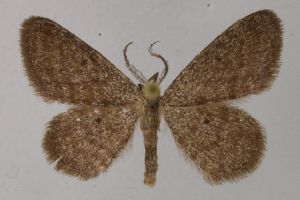

 +1Kontinente:EU
+1Kontinente:EU2. Diagnose
2.1. Männchen
3. Weitere Informationen
3.1. Etymologie (Namenserklärung)
Wenn man einen Namen für die 1000ste Spannerart in Europa sucht, dann darf man dieses Jubiläum auch zur Benennung der Art nutzen! Die Autoren der Erstbeschreibung erläutern: "Etymology: The species name was given referring to the fact that this is the first European species described after the completion of the book series 'The Geometrid Moths of Europe' which contains 999 European geometrid species. After the new record for Europe of Athroolopha latimargo Rothschild, 1914 in Spain (Guerrero et al. 2020) and the downgrading of Rhodostrophia discopunctata Amsel, 1935 to subspecies rank of R. calabra (Petagna, 1786) (Hausmann 2020), this new species seems to be the thousandth geometrid species of Europe (latin millesimus, -a, -um: the thousandth)." [Da wir im Lepiforum Europa geographisch etwas weiter fassen, ist es hier bereits die 1.099ste Art.]
3.2. Taxonomie
Hausmann (2020) stellt die neue Art in die "Idaea nocturna species group", eine Gruppe, die in Europa bisher nur durch die beiden Typusexemplare von I. millesima bekannt ist, und deren Vertreter alle düster gefärbt sind und durch bipectinate Fühler gar nicht so recht in die Gattung Idaea passen wollen (wohin sie aber genetisch eindeutig gehören). Der genetische Abstand zu den anderen Arten der Gruppe - die in Europa alle fehlen - ist groß: "Genetic data (Fig. 1): BIN: BOLD:ABW0363 (t:2 from Greece). Genetic distances from the other representatives of the species group Idaea medianocturna sp. n. (6.4%), I. nocturna (6.9%), I. beata sp. n. (7.1%), I. zoferata (8.1%)."
3.3. Faunistik
Die Art ist bisher nur durch die 4 Männchen der Typenserie bekannt, die alle am 19. Mai 1992 bei Tseria am Taygetos auf dem Peloponnes (Griechenland) gesammelt wurden.
3.4. Typenmaterial
Die Autoren der Erstbeschreibung erläutern: "Type material: Holotype: Male, Greece, Peloponnese, Taygetos, Tseria, 19.V.1992, leg. T. Dobrovsky, coll. ZSM (DNA barcode ID: BC ZSM Lep 56957). Paratype(s): 1 male, id., coll. J. Prochazka (DNA barcode ID: BC ZSM Lep 56958; gen.prp.nr. Proch-12001); 2 males, id., coll. T. Dobrovsky".
(Autor: Erwin Rennwald)
3.5. Literatur
- Hausmann, A. (2004): The Geometrid Moths of Europe Volume 2: Sterrhinae: 1-600. Stenstrup (Apollo Books).
- Erstbeschreibung: Hausmann (2020): Revision of the West Palaearctic Idaea nocturna species group (Lepidoptera, Geometridae, Sterrhinae). — Mitteilungen der Münchner Entomologischen Gesellschaft 110: 71-80. [PDF auf zobodat.at]




